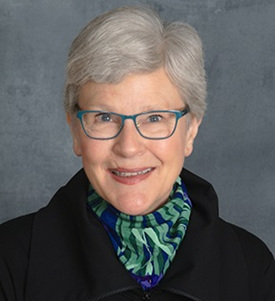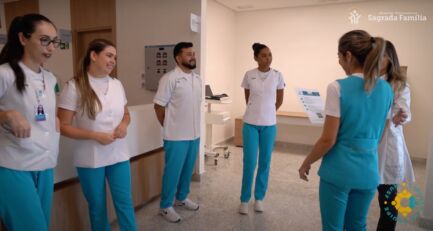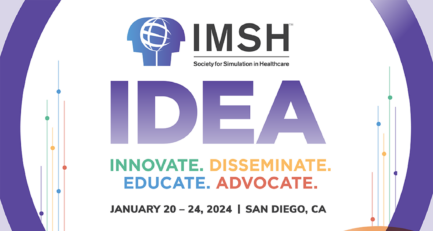
CMS: Welcome to Brief Debriefings from the Center for Medical Simulation, our conversations with our colleagues and friends from all over the simulation world; check-ins about the projects that they’re excited about, projects that they’re working on especially right at this moment in light of all the changes in the simulation world due to the COVID-19 pandemic.
I’m here today with Suzie Kardong-Edgren. Suzie is a Senior Fellow at the Center for Medical Simulation and she has been working on a couple of projects she’s really excited about with the Massachusetts General Hospital Institute of Health Professions, in particular their master’s program in simulation operations and their PhD program in simulation. Suzie, welcome, so excited to have you here.
What I’d like to do is just you know have a little conversation about the projects that you’re working on particularly the personal projects the simulation projects that are most interesting to you, how any of those projects have changed over the course of the last three or four months, and if you see simulation differently in context of current events or how you see simulation moving forward. I’m particularly excited to talk to you about how you see the shape of the field changing moving forward just given how involved you were in some of the shaping of the field with the 50% study and how it has changed how Nursing trainings are being done.
I think in this moment we’re talking to a lot of people about how they’ve become more and more involved and critical to real live care and real designs for how care in the moment is being done as opposed to being seen as a training and education resource.
Suzie Kardong-Edgren: So one of the things I can tell you that is the bane of existence for any nurse educator is trying to get nursing students to understand the importance of sterile technique. I don’t think that’s going to be a problem anymore. Our textbooks were a lot thinner when I was a student, about when dinosaurs roamed the earth, but we got it the first time out of the box we learned it and I know teach it a little bit differently now but I know that the time I have been teaching myself I know that nurses really just didn’t seem to, and I will say that many in my hospital also don’t seem to get it which is why we have some of the infections that we do.
This pandemic has really brought to the fore the lack of understanding. They use simulation to teach first time or reinforce sterile technique for everybody so I think that’s a good thing. I’m sorry it took a pandemic to make it happen but it’s good. We will probably have fewer infections overall going forward, however being able to tease out the effect of nurses actually doing really good sterile technique versus all the other things we’re doing today, I don’t think that would be possible.
The other thing I think has been really great moving forward is, I know VR was going to be big but now I know it’s going to be the next big thing. I think this is really forcing the issue very quickly for many people, and the reason for that is talking with one of my buddies, she said when she called the mannequin manufacturers right after COVID-19 got going and said how do we disinfect our mannequins she was basically told, “Oh, use soap and water,” and she said, “No, that’s probably not going to do it, I need a little more from you,” and they had not really thought about that.
CMS: I’m just thinking about the amount of physical contact that that happens when we’re in the room with the mannequin in the context of our primary goal, which is that simulation never harms a real patient and never harms a provider. Thinking about the principles that Dan Raemer and Ann Mullen and are working on with their simulation patient safety work. The idea that you could have a provider who had some viral shedding going on interact with a mannequin, not clean it enough, and then have another provider pick that up and spread it to a patient is antithetical to those principles.
Suzie Kardong-Edgren: Absolutely– so I always knew that VR would be next. I’ve been telling people for about a year and a half when they’re building a new sim center, I say don’t spend a lot of money on mannequins right now. I think the mannequin was a waystation. Perhaps you are like me, I grew up watching Star Trek, and I want the holiday now in my lifetime, before I retire. That may be pushing it but I think that’s where we’re going.
I think this has really aided in that discussion as we go forward. So with that in mind, before all of this stuff started I was working on a couple consulting gigs with different groups. One of them is called the Nursing Community Assessment Service in British Columbia, and they have been using simulation to evaluate all nurses coming in from foreign countries before they get licensed in British Columbia. They were having great outcomes with that and they were very forward-thinking, and also they were aware that education in other countries may not be on the same level as what we expect in Canada and the United States from a registered nurse.
The evaluations they developed they test two things at the same time, actually three things. One, for basically a patient care technician or a LPN and for an RN. They’ve been very successful with that so that was something that was lovely because it was going to become a standard and they’re willing to do it for people who come in from other countries but not yet in their own country which I think is very interesting.
So that was floating around out there and then the NBCRNA which is a national board of certification and recertification for nurse anesthetists was looking at the use of simulation for recertification of their CRNAs. They were going to run a series of scenarios to make sure that people have not forgotten things and are refreshing things.
VR would be really great and it’s true now that everybody’s afraid to touch mannequins at this point in time and everything’s been put on hold, and VR companies are just running, running, running to capture market and to build things that we need now that would be more appropriate as we can’t go back to school. We are thinking about how are you going to scale mannequin-based simulation when you’ve got 200 students you have to get through, and you have to clean that room after every group goes through.
CMS: You’re talking about really doing summative evaluation with it as opposed to doing formative work.
Suzie Kardong-Edgren: Yes. Another thing that’s happening is we just won article of the year from Clinical Simulation in Nursing for work that Nancy Sullivan and some other people and I worked on: a two to one ratio survey looking at literally, what are you doing in traditional clinicals, what are you doing in mannequin based simulation, and a third arm now is going to be what about screen based simulation. We did not want to get into VR at this point because we don’t know how many programs are out there that are using virtual reality. I think it will be more in the future but right now screen based made more sense.
For that study the hard work has been done because the figuring out how to describe and code each of the things that is happening during the traditional sim–it was very labor intensive but it’s done, so I think moving forward those things are available to anybody. If they wanted to reach out to say, we want to do this our own place, absolutely, we welcome that opportunity for others to use that coding system.
This becomes more important as people are wondering, “Are we going to be able to go back into the hospital with students?” and of course I would say I think that we are giving mixed messages. I would think we would want the student nurses in the hospital at this point in time learning seriously how to take care of patients or helping out areas where maybe they’re not on the COVID floor, on the regular med/surg floors, etc. We didn’t do that, because there was going to be a shortage of PPE. Now there’s not, so the question then becomes are we not letting students back into the hospitals because we worry about in case they get exposed. I’m curious to see what happens in the fall.
CMS: I wonder… from one perspective, like you said, it’s definitely about mitigating risk in the sense that the fewer people who are in the room, the fewer people who have a potential exposure. I think also because you want people to be able to make errors, particularly trainees, in as safe an environment as possible, hence simulation in the first place, doing these procedures for the first time on a simulated patient as opposed to a real-life patient who can be harmed.
I see those both a little bit in the same way, which is to say it takes a lot of cognitive load, even for an expert, to safely don and even more importantly safely doff PPE in a COVID positive environment. We’ve been talking to sim directors and education leaders around the country about this and all sorts of efforts are going into making sure that this happens safely. Whether that’s creating a doffing expert who is literally a consultant who comes and just checks and makes sure that everyone is doffing safely after they’ve gotten over the threshold of completing the procedure– and that’s checking in with attendings and senior people, super experienced people. For a trainee, making a mistake in that regard, the risk is fairly high that an error might occur. You’re comparing that chance to the potential consequence of that error, which in normal circumstances would be minimal and now it’s quite great, and potentially creates the potential for community spread and all those things.
Maybe sim is the environment, if we can get trainees in a simulated COVID room and have them practice that in the same way that their more senior colleagues are using sim to practice, then maybe it mitigates or eliminates some of that risk.
One thing I’d be interested to get your perspective on, since you were talking a little bit about screen based learning: We are working with some of our partner organizations on how to effectively replace clinicals, particularly for students who are in nursing schools right at this moment and can’t go into the clinical environment. We’ve been working on doing things like unfolding virtual case studies that are screen based, things like standardized patients using the virtual environment, all the way up to using some of the more complex simulation apps.
Part of our motivation for that has been this idea that while it’s really hard to shift those trainings that have been clinical to an online environment, the critical thing is to not turn a short-term risk mitigation measure into long-term risk, in the sense that the long-term risk would be students emerging from nursing school who haven’t been trained fully and then of course you have a potential for a long tail of error down the road from people who haven’t gotten satisfactory training. How do we basically prevent a lost generation of nurses who didn’t get their clinicals or even worse wash out of the profession because their training wasn’t sufficient in the time that they were in nursing school?
Suzie Kardong-Edgren: Unfortunately, they’ll still be able to pass the board even without the extra training. Cognitively they’ll come out prepared. The issue that you’re raising is one that I think the NBCSN also needs to seriously consider. I hadn’t really thought about it in the sense of a “lost generation of nurses” but I’m thinking it’s kind of what’s going to happen.
One thing I’m going to say about screen-based sim compared to virtual reality or mannequin-based simulation is, and this is anecdotal, but I have seen it happen over and over and over again. When I was helping with the research with RTI which is a resuscitation program, people go through a training online first. You get the AED and you open it up and you put the patches on the human and you turn it on and it talks to you and then you shock the patient. It’s screen based. Then we were doing it with real people and I walked in the room the person’s pumping away and then now I hand her the AED, she looks at me and she says, “What is this?”
I said, “This is the AED.” She said, “I’ve never seen this before.” I said, “Not only have you seen it, you used it in your screen based learning.” I noted to myself, just because you do it on the screen does not mean you recognize what it is in the real world. So there are limits to what you can do with screen based things.
With VR, I do believe that there is something to the proprioception, the moving your body through space, the laying on of hands, different things whether you can feel them or not. I do think we would be making a huge error if we really rely on screen based things all the way. Having said that can you get a certain amount of emotional engagement with that, absolutely. There’s work that’s very engaging, students love it, and it’s basically done through a choose-your-own-adventure kind of screen based simulation. She has kind of perfected the technique and because she’s funded by the Canadian government the more people who use her stuff for free, the more money they give her to build more stuff, so she is a great wealth of resources and wealth of information on that kind of screen based technique.
CMS: I think that’s a really good look at some of the issues that are facing nursing education in particular in the moment, where clinicals aren’t really happening. How do we translate some of that to a screen-based environment, a virtual environment, and what are some of the drawbacks and positives of that? So thank you so much Suzie Kardong-Edgren for this conversation.
Suzie Kardong-Edgren: Thank you for asking me.

